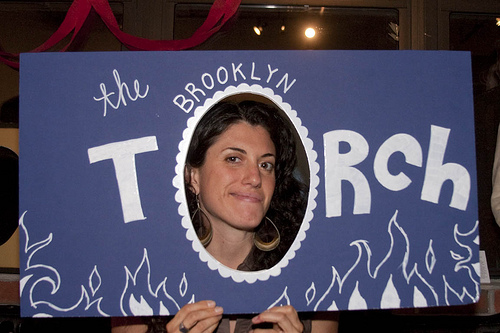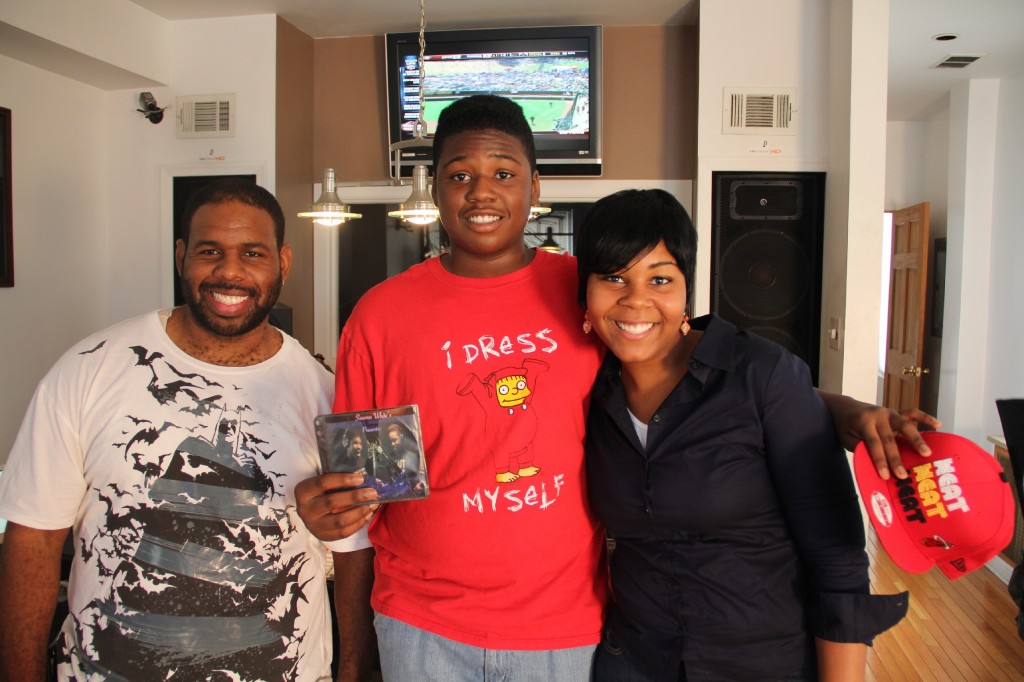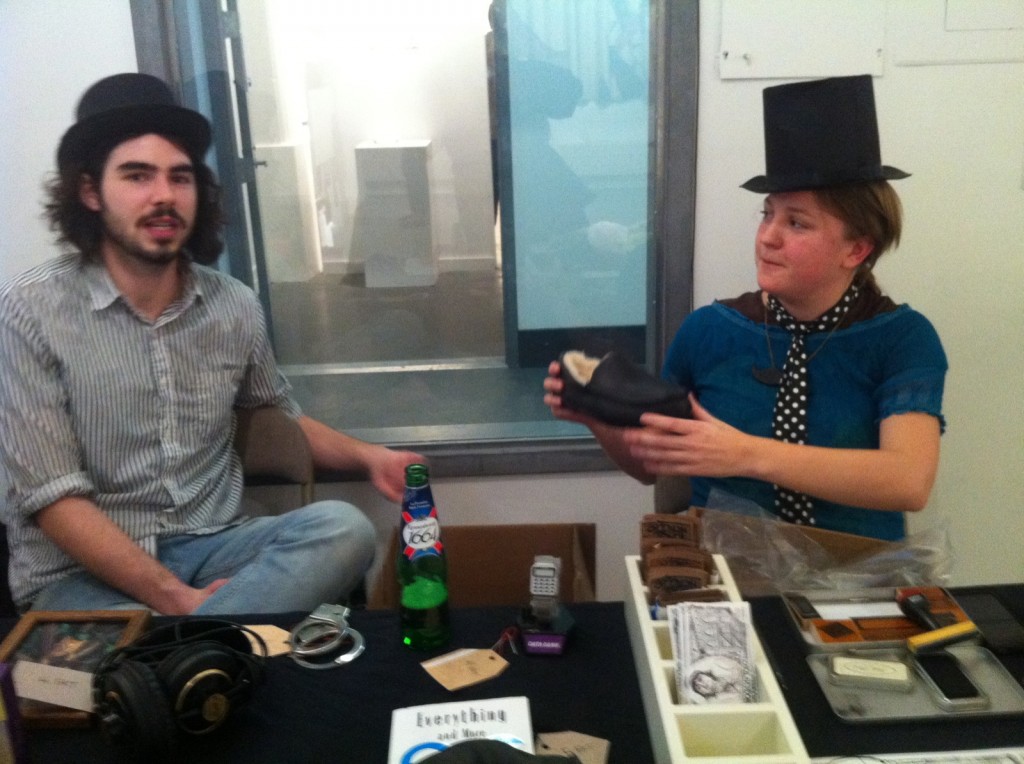Mary Jeys & Sinema White
Leave a CommentEach year, our artist development program, Create Change, supports 15 to 20 artists developing their socially engaged creative practice through our Fellowship, Residency, and Commissions program. In 2012, we began asking our Create Change artists to pair up for Creative Conversations: open-ended creative exchanges to be published on our blog. Read on to meet our Create Change alumni.
Mary: What was your process for making music during your Laundromat Project Create Change residency?
Sinema: My music usually starts off with a conversation or a real life event. I usually have to go through something to be able to create music. When going into the laundromat with intentions of creating music with my community, it had to happen the same way. I engaged customers in conversations about school, their personalities, their experiences and things like that. I then asked them to use their situations to someone else’s advantage by creating songs. These songs would inspire someone else and also give insight. Of course they’re eager to participate if they know that they can show off their talents. We played instrumentals on a radio and banged on tables to have background music and then freestyled or wrote our thoughts down in a style that rhymed. We then rehearsed these lyrics atop of music a few times and even got others involved with us. At a later date, the kids recorded their songs in a studio and took photos for cover art. The songs got pressed to disc and given away for free to people washing clothes at our home laundromat.
Mary: What was it like working where you live?
Sinema: Honestly, I swore that because I made music with communities prior to the residency that it would be very simple to engage my own community in songwriting and recording. What happened was the complete opposite. I was always so busy going to schools and recreation centers in other neighborhoods that I had never even worked in my own neighborhood. This is partly because a lot of the people I run into around my neighborhood are either really defensive or really afraid when it comes to dealing with someone they don’t know so when the thought of dealing with my neighborhood ever came around I completely snubbed it. Although I probably should have anticipated that it would take me about four laundromat visits on Saturday and Sunday afternoons to find participants for my project Giving Hope Away, this was completely unexpected. The parents of my community were not as eager as I’d assumed to allow their kids to chat, write, sing and rap with me while doing their laundry at first. This prolonged me entering into the community for almost a month although I’ve lived there for years!
What project were you working on during your Create Change professional development fellowship, Mary, and who did you hope to reach?
Mary: I have been working on a local currency initiative since 2009. I was especially interested in progressing the project in a context including other socially engaged art practitioners.
I wanted to engage my neighbors, and I defined them as everyone from my Polish landlady and her friends to the new arrivals in newly constructed condominiums and the long standing Latino neighbors on the south side of Williamsburg to the artists as well as all of the small businesses throughout the area.

Sinema: Why this project?
Mary: In a previous project, I performed as a campaign manager for a fake candidate in 2008. I became very interested in bringing performative/design/art interventions to people who hadn’t self-selected as an arts viewer (i.e. on the sidewalk instead of a gallery/arts space). At the time, I was unemployed and looking for a project that would not only be fun for me but also would invite my own neighbors to participate. I was interested in exploring the idea of wealth, and eventually settled on the idea of setting up a local currency.
Sinema: How did you hope your project would build relationships within your community?
Mary: When I began, I knew that a perfect venue to present it would be FEAST. The dinner format combined with instant grant was a clear fit, and it seemed kismet that FEAST was being held two blocks from my art studio (i.e. in my neighborhood). By voting for my local currency project, my community participated directly in the creation of the project. I stood in front of a room of hundreds of my neighbors as the first step, and in the following FEAST event, I helped them visualize what might be on our local currency. Drawings, collages, and written ideas submitted then were synthesized as communal visual culture onto the graphic design prototype.
How did you use your laundromat space?
Sinema: Because my project also took place in a costly recording studio, I really enjoyed using the laundromat for rehearsal space. We utilized the folding tables as desks to write songs and to bang on to make beats. We rehearsed our music in the middle of the Laundromat in order to perfect our skills and recruit others into working with us.

Mary: What is your favorite thing about your neighborhood?
Sinema: I love that there are many places, such as churches, parks and community centers, for the youth to hang out after school. Because there is so much violence in Philadelphian communities, it’s a relief to know that there are positive places in our neighborhood so they can stay out of trouble.
How was it working with your community?
Mary: I found a lot of volunteers who spoke up quickly for their enthusiasm for the project and willingness to participate. What I have find much more challenging has been the process of taking the next step in finding a role that fits the volunteer as well as not overwhelming their good intentions by overloading them with too much responsibility.
Did the Create Change program inspire you to change your own practice of making art?
Sinema: Not at all! It actually encouraged me to keep doing the same thing that I’ve been doing! It let me know that what I was doing was powerful and it really made a difference. The backing I got from The LP really inspired me to keep doing my projects no matter what. Although hosting a project like this costs a lot of money and the funding is not always there, I’m now inspired to really find a way. Honestly, you don’t need money to bring people together. Just getting the youth to come together and speak on their emotions is enough! There’s so much that would be prevented if they just spoke their minds! Create Change really made me see the light and realize that it’s foolish to not be engaged just because you don’t have resources. The only resource we, as artists, ever need is our warm spirits. The fact that we want to take time out of our lives to make a difference in someone else’s really matters a lot.
What does social change mean to you?

Mary: Social change to me indicates a shift in understanding relationships between people or groups of people. In the role of an artist, I understand my position as someone who can facilitate, or highlight change in social relationships.
Sinema: Do you feel like you created a social change in your community?
Mary: That is a hard question to answer. It is hard to gauge what effect I may or may not have had in the culture of change in my neighborhood. I do believe I participated in a conversation about our economy and helped inspire a sense of creative control. I believe engaging in positive, inclusive conversation has made an impact and broadened understanding of local business as not only storefronts, but also neighbors with whom we can share goods and services as well.

Sinema: Although the Create Change program is over, do you feel like your involvement with your community is over?
Mary: No, in some ways, it is just beginning. I have renewed my contact with key project advisers and am working my way to bring the project to a new place of fruition. I have started a collective workspace share and we are dedicating our programming’s focus to social engagement. This will allow this project and others like it to have a home within our community, and of our community.
Sinema: Did you learn anything about your community that you don’t think you would have known if your project hadn’t been done?
Mary: I learned how open and exciting my neighbors are. Many of them are so eagerly looking for good things to participate in. So many are happy to have a conversation about issues and to be given a platform for voicing their hope and potential for positive change, especially small business owners. I initially anticipated that they would be the hardest to convince, but what I found is that they were the most eager. Small business owners are a lot like artists–they have a vision and work towards achieving it every day, despite a lot of odds against success.